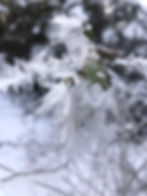Hoar Frost
- katemacquarrie22
- Jan 22, 2023
- 2 min read
Even if you’re not a fan of the PEI winter, I bet you’d agree that few things are more beautiful than hoar frost. Under certain conditions, feathery ice crystals coat trees, twigs, and fence lines, turning the Island landscape into something magical. Today, let’s look at hoar frost and how it differs from other types of ice.
‘Hoar’ is an old word for feathery white, like a beard. You might not hear it much in everyday conversation, but we use the term ‘hoary’ in botany quite commonly to describe a plant covered in dense grey or white hairs. It’s an apt description of this type of frost, as you can see in Photo 1.

Regular frost – the sort that concerns gardeners in spring and fall – forms when moisture in the air condenses on a surface (like my tender tomato plants!) and then freezes. Hoar frost skips that condensation step: when moisture in the air meets a surface that is already below freezing, it goes straight from gas (water vapour) to solid (ice crystals). Water vapour continues to contact those ice crystals, and so the hoar frost grows. Hoar frost forms in cold weather under clear skies and calm winds.
There is another type of ice commonly mistaken for hoar frost: rime. Rime ice forms under cloud cover and usually in foggy conditions. In this case, the moisture in the air is a super-cooled liquid. That means that its temperature is below zero – in some cases as low as -25C (-13F) – but it is still in liquid form. It needs to come into contact with something solid to kick off the nucleation process and turn it into ice. You may have experienced this yourself with a bottle of pure water left in your car in icy conditions. It’s liquid, but then you give it a tap and it immediately freezes. It was supercooled!
Hoar frost is delicate, can be easily brushed away, and disappears quickly. Rime ice is heavy and can build up on trees and power lines weighing them down. Hoar frost is decorative and doesn’t cause any problems. Rime ice may be beautiful, but can damage trees, cause power outages, and make roads slippery. And, as my fellow pilots know, rime is dangerous to aviation and a good thing to avoid!

I recently came across an isolated patch of hoar frost near a pond. The pond wasn’t yet frozen, and so was providing a good source of moisture for the air. In Photo 2, you can see the hoar frost formed on only one side of the twig – the side facing the pond. Cool natural processes like frost formation are another part of PEI – untamed!